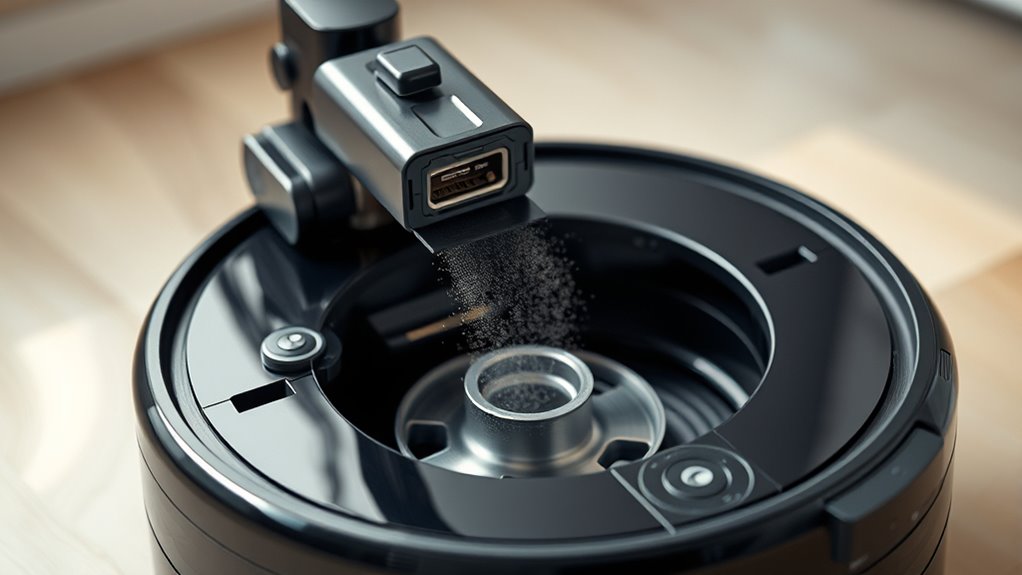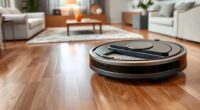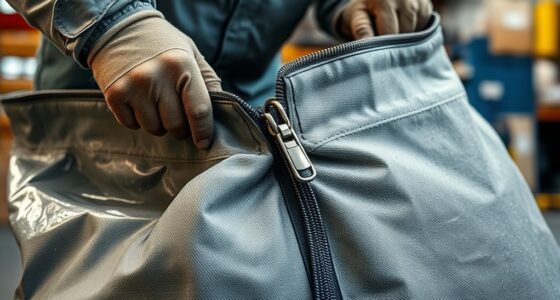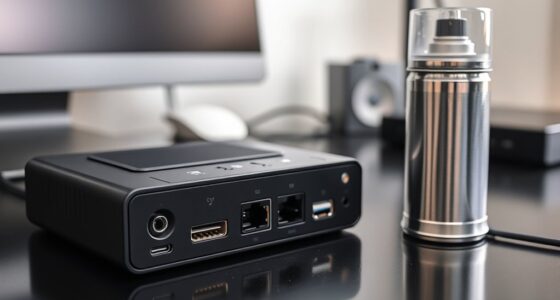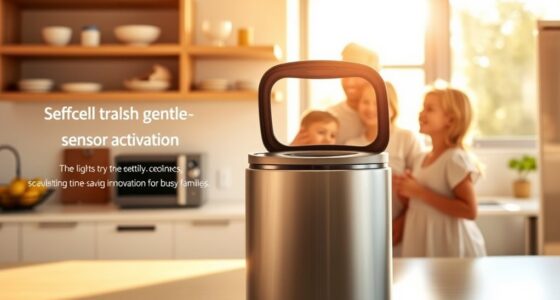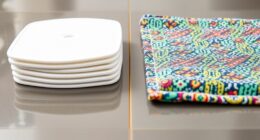Self-emptying robot vacuum dustbins work by automatically transferring debris from the vacuum’s bin into a larger station or base when it’s full. Sensors trigger this process, causing the vacuum to dock and activate a motorized mechanism that empties the debris into a bag or container in the station. This seamless process reduces manual emptying and maintenance efforts. To discover more about how these systems optimize cleaning, keep exploring the details behind their operation.
Key Takeaways
- Sensors detect when the robot’s dustbin is full and trigger the emptying process.
- The vacuum docks automatically at the self-emptying station for debris transfer.
- A motorized mechanism transfers debris from the vacuum’s dustbin into a larger station bag or container.
- The process is quick, clean, and seamless, minimizing manual handling of debris.
- Regular maintenance of the station and sensors ensures smooth operation and prevents overloads.
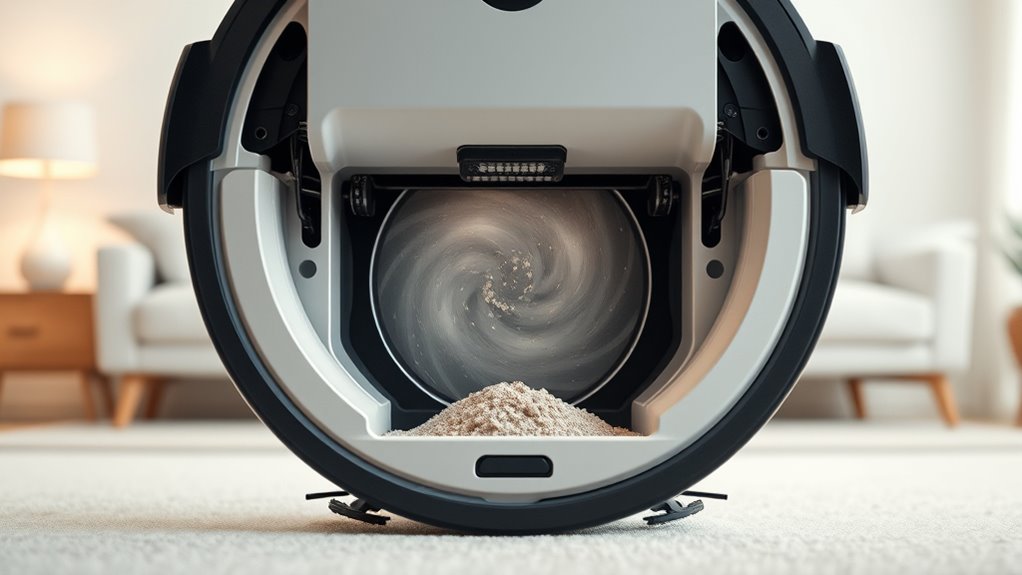
Have you ever wondered how much hassle it saves to have a robot vacuum that empties itself? With a self-emptying dustbin, you no longer need to worry about constantly checking or emptying the vacuum’s dustbin after every use. Instead, the vacuum automatically transfers the collected debris into a larger bin located in a station or base. This design considerably reduces the frequency of robot vacuum maintenance, making your cleaning routine more effortless and less time-consuming.
When your robot vacuum operates, it gathers dust, dirt, and pet hair from your floors. The dustbin capacity determines how much debris the vacuum can hold before it needs to be emptied. A smaller dustbin may require frequent stops during cleaning, especially in homes with pets or high foot traffic. On the other hand, a self-emptying system usually features a larger, more durable dustbin in the station, which can hold multiple cleaning sessions’ worth of debris. This means you can run the vacuum for longer periods without interruption, ensuring thorough cleaning without constant supervision.
The key to a smooth self-emptying process lies in the design of the station and the vacuum’s ability to communicate effectively. When the dustbin in the vacuum fills up, sensors trigger the transfer process. The vacuum automatically docks at the station, where a motorized mechanism empties the dustbin into a larger bag or container. This process is quick, clean, and seamless, so you don’t have to handle dirt or messes manually. Proper maintenance of your robot vacuum involves ensuring the self-emptying station functions correctly. Regularly check for blockages or full bags in the station to prevent overflow or malfunctions. Also, keep the station and the vacuum’s sensors clean, so the transfer process remains smooth. With a good understanding of dustbin capacity and routine upkeep, you can extend the lifespan of your device and maintain ideal performance over time. Overall, self-emptying dustbins offer a hassle-free way to keep your floors clean while reducing the time and effort spent on robot vacuum maintenance. It’s a smart upgrade that lets you enjoy a cleaner home with minimal intervention. Additionally, understanding the dustbin capacity helps optimize your vacuum’s efficiency and reduce the frequency of emptying.
Frequently Asked Questions
How Long Does the Dustbin Take to Empty Automatically?
When your robot vacuum’s dustbin fills, automatic emptying springs into action like a busy bee. It usually takes just a few seconds for the dustbin to be emptied, depending on its capacity. Larger dustbins mean less frequent trips to empty, while smaller ones fill up quicker. So, as your robot works tirelessly, you can relax knowing the automatic emptying process is quick, seamless, and keeps your home spotless without missing a beat.
Can the Dustbin Handle Wet or Damp Debris?
No, most self-emptying robot vacuum dustbins aren’t designed to handle wet debris or damp residue. Attempting to put wet or damp materials into the dustbin can cause clogs, damage the bin, or lead to mold growth. To keep your vacuum functioning properly, only dispose of dry debris. If you encounter spills or damp messes, clean them up manually before running your robot to prevent any issues.
What Is the Maximum Capacity of the Dustbin?
Did you know the average self-emptying robot vacuum dustbin holds about 2 to 4 liters? The dustbin material, usually durable plastic or metal, guarantees longevity, while the dustbin design maximizes capacity without increasing size. You can expect the maximum capacity to vary based on the model, but generally, it’s enough to handle a week’s worth of debris, making your cleaning routine more efficient.
How Often Should I Manually Clean the Dustbin?
You should clean the dustbin after every few uses to maintain peak performance. Regular cleaning extends the dustbin lifespan and prevents clogs that could lead to dustbin replacement sooner than expected. If you notice reduced suction or lingering dust, it’s time for a manual clean. By staying on top of dustbin maintenance, you ensure your robot vacuum continues to work efficiently and avoids unnecessary dustbin replacement down the line.
Are There Specific Maintenance Steps for the Dustbin?
You’ll want to regularly check your dustbin for clogs or buildup, especially around the dustbin filter and dustbin material. To keep it running smoothly, remove the dustbin, empty it, and wipe down the dustbin material with a damp cloth. Also, inspect and clean the dustbin filter to guarantee maximum airflow. Doing these simple maintenance steps helps your robot vacuum perform better and last longer.
Conclusion
Now that you understand how self-emptying robot vacuum dustbins work, you can see they’re like your loyal cleaning companion, tirelessly taking on the mess while you relax. Their seamless design keeps your home tidy without the hassle of frequent emptying—truly a game-changer in home automation. With these smart systems, you won’t just keep your floors clean; you’ll also reclaim your time, turning chores into a thing of the past.
